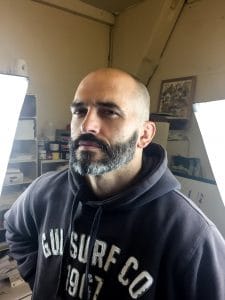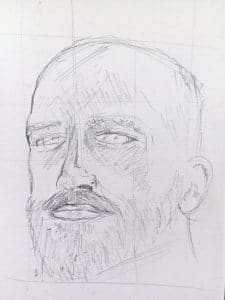A Portrait of an Ex-Artist
When I do draw a face it ends up one of three ways:
- I start drawing, and after about a minute I look at what I’ve done. I can already see it’s awful and has no hope of forming into something recognisable, so I quickly try to turn it into a picture of something else… a dog, a lighthouse, anything – just in case someone else sees what I was trying to achieve and laughs or cries or something.
- I follow it through and see it to the bitter end. The result is a strange house-of-mirrors creation. Elongated or mutated like some plastic surgery mishap or Christopher Lloyd after he’s been flattened in Roger Rabbit. I quickly annihilate the paper lest it be seen.
- It’s a cartoony face. That’s ok – I can do that, but that’s not the point – it’s not a real face.
It extends to pretty much any drawing of ‘real’ things – but it’s never so obvious as in a face. When I try to draw a portrait I always give up before I’m finished, at a point when the picture looks pretty awful.
So it was with fascination that I watched Sky Arts’ National Portrait Artist of the Year. It’s a simple premise that’s enthralling to watch. A group of artists all paint the same subject. From our armchair we can watch how various, uniquely talented individuals create from nothing – each with their own method and wildly varying outcomes.
Design (what I do) is a controlled type of creativity – creativity within constraints. Painting, fine art, sculpture is freedom of creativity. These artists on the telly live in a world without goals, targets or boundaries – it’s a blank canvas, an open road.
Sure, some of their portraits were total crap – but that’s part of the beauty of it. Art is subjective, without criteria for success. In short, art is for it’s own sake, design is for purpose. Watching this array of artists do whatever–the-hell-they-wanted made me want a piece of that liberation, so I decided to take a dive in at the deep end and paint a portrait.
 I decided to paint Andy – he’s got a pretty angular head, which suits the style I wanted to go for – a kind of angular, palette knife approach favoured by the insanely talented winner of Season 2, Christian Hook.
I decided to paint Andy – he’s got a pretty angular head, which suits the style I wanted to go for – a kind of angular, palette knife approach favoured by the insanely talented winner of Season 2, Christian Hook.
I opted for acrylics, mainly because I probably would get in trouble if the lounge stank of linseed oil for a month. My plan was as follows: first do some sketches. Hopefully one will look something like a real human. Even better if that human was Andy. Then I’d paint a study. I got a tiny canvas free with a larger one – which I decided would be a good thing to practice using the paints on, make some mistakes and learn the skills I needed to take on my final challenge; a two by two foot canvas. My only hope was that it looked something like a real person. Artistic flair would be a bonus.
 Things started pretty well. I drew a god-awful freehand sketch of some long-headed freak, but my follow-up drawn using an overlaid grid was pretty good. It looked like Andy. After another, more stylised sketch which was a step in the wrong direction I decided to tackle the test canvas.
Things started pretty well. I drew a god-awful freehand sketch of some long-headed freak, but my follow-up drawn using an overlaid grid was pretty good. It looked like Andy. After another, more stylised sketch which was a step in the wrong direction I decided to tackle the test canvas.
I started again with a sketch, just the eyes for this one. I then painted the canvas red because I’d seen some people do it on the telly. I didn’t really know why at the time – but in retrospect it kind of helps to tie the painting together, and enables you to really see what you’re painting – skin colour on white is a bit of a hard thing to visually parse.
My first go was a bit of a brown mess, things got muddy fast. My palette was shades swamp and the painting not much better. It actually turned out to be a good move using acrylic – I scraped a load off and started again, working freely over the paint which had already dried enough to be re-worked. This time I mixed just a few key colours on the palette.
 At some point in the next hour of painting, scraping, painting, scraping – a couple of things happened. Firstly it occurred to me that I’d barely finish the study in my feed day, let alone the main portrait. I’d have to make the little one as good as it can be. The second was a little more… profound I guess. Something clicked. I started to be able to feel the paint building the face. It became less important what was on the canvas in front of me, and more important how what I was doing related to what had gone before and what would come next. Directions of the brush created planes of the face – tiny specks of colour transformed the appearance of the whole eye or cheek or nose.
At some point in the next hour of painting, scraping, painting, scraping – a couple of things happened. Firstly it occurred to me that I’d barely finish the study in my feed day, let alone the main portrait. I’d have to make the little one as good as it can be. The second was a little more… profound I guess. Something clicked. I started to be able to feel the paint building the face. It became less important what was on the canvas in front of me, and more important how what I was doing related to what had gone before and what would come next. Directions of the brush created planes of the face – tiny specks of colour transformed the appearance of the whole eye or cheek or nose.
Most crucially, I totally gave up on each stroke needing to be the one that makes the portrait look finished.
In design I’m used to the final product coming from a long and detailed process. The early stages don’t give you the finished picture, instead an outline of what the project is, how the outcome will take shape. Slowly, through that process you move inexorably towards the outcome, and it’s only right at the end that it can potentially become recognised by everyone as something special.

And I think that’s where I’d gone wrong all those times drawing faces before. I’d always put pressure on myself with drawing to be able to put a few marks down and to have created something magical. Some people can do that, sure, but clearly not me.
In fact, like design, painting can be a series of processes. You have the micro process of building up that painting from something basic and unformed to something finished and beautiful. You have the macro process of developing your own style – figuring out how you attack the canvas, what your method of interpreting the world is.
As it turned out, I’m pretty pleased with the painting. It’s kind of what I hoped it would be and certainly better than I thought It might be. Don’t get me wrong – I can see it’s no masterpiece… but for me it was the process that was most satisfying.

If I did the painting again I’d approach it totally differently. I’d still start with a sketch, but then I’d not even bother trying to make a face – instead I’d figure out shapes and colours, safe in the knowledge that towards the end I could bring in the detail and marks that make it ‘real’. If I carried on, making painting after painting for years my process would develop into something I could trust to get the picture where it needed to go, without worrying about what it looks like when it’s only halfway there.
Painting a portrait is very different from my day-to-day design work, but not entirely in the way I’d expected. In design the outcome is everything – brief, goals and objectives are measurements of success – characteristics that aren’t always considered when approaching a canvas. However the beating heart of both is the same. Create something beautiful, and find your own way of doing it. Once you know your process, trust it, enjoy it. Don’t expect immediate results – be patient and good things will come.

